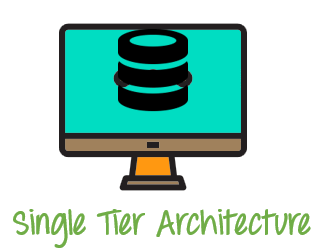DBMS Architecture: 1-Tier, 2-Tier & 3-Tier
DBMS Architecture: 1-Tier, 2-Tier & 3-Tier
Posted By Manisha Gupta
What is Database Architecture?
DBMS architecture helps in design, development, implementation, and maintenance of a database. A database stores critical information for a business. Selecting the correct Database Architecture helps in quick and secure access to this data.
- What is Database Architecture?
- 1 tier Architecture
- 2-tier Architecture
- 3-tier Architecture
1 tier Architecture
Figure 11-tier Architecture Diagram
The simplest of Database Architecture are 1 tier where the Client, Server, and Database all reside on the same machine. Anytime you install a DB in your system and access it to practise SQL queries it is 1 tier architecture. But such architecture is rarely used in production.
2-tier Architecture
A two-tier architecture is a database architecture where
- Presentation layer runs on a client (PC, Mobile, Tablet, etc)
- Data is stored on a Server.
An application interface which is called ODBC (Open Database Connectivity) an API which allows the client-side program to call the DBMS. Today most of the DBMS offers ODBC drivers for their DBMS. 2 tier architecture provides added security to the DBMS as it is not exposed to the end user directly.
Example of Two-tier Architecture is a Contact Management System created using MS- Access.
Figure 22-tier Architecture Diagram
In the above 2-teir architecture we can see that one server is connected with clients 1, 2m and 3. This architecture provides Direct and faster communication.
3-tier Architecture
3-tier schema is an extension of the 2-tier architecture. 3-tier architecture has following layers- Presentation layer (your PC, Tablet, Mobile, etc.)
- Application layer (server)
- Database Server
Figure 3 3-tier Architecture diagram
This DBMS architecture contains an Application layer between the user and the DBMS, which is responsible for communicating the user's request to the DBMS system and send the response from the DBMS to the user.
The application layer(business logic layer) also processes functional logic, constraint, and rules before passing data to the user or down to the DBMS
Three tier architecture is the most popular DBMS architecture.
The goal of Three-teir architecture is:
- To separate the user applications and physical database
- Proposed to support DBMS characteristics
- Program-data independence
- Support of multiple views of the data
Example of Three-teir Architecture
Any large website on the internet, including guru99.com ??
Summary
- DBMS architecture helps in design, development, implementation, and maintenance of a database
- The simplest of Database Architecture are 1 tier where the Client, Server, and Database all reside on the same machine
- A two-tier architecture is a database architecture where presentation layer runs on a client and .data is stored on a Server
- 3-tier architecture is consist of the Presentation layer (PC, Tablet, Mobile, etc.), the Application layer (server) and Database Server



